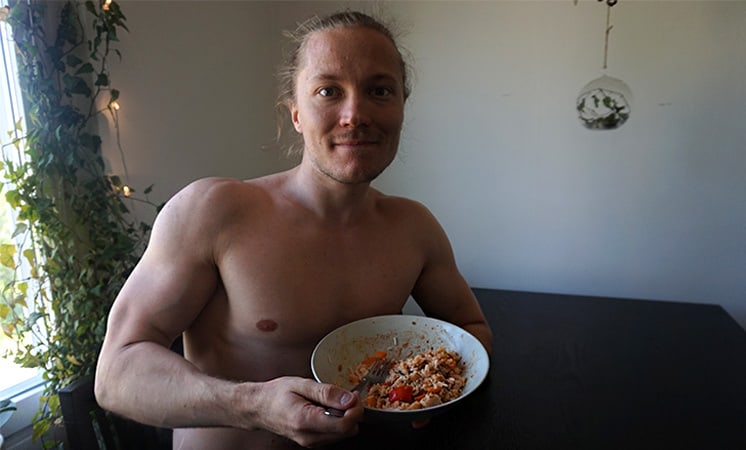
If you want to get a downright ripped physique, learning how to set up your macros is key. In fact, your macros are the second most important factor for fat loss. So, I decided to research the topic to find out what the best macros are when cutting and I also tried them out myself. And here’s what I learned:
What’s the best macros for cutting? To achieve a lean, muscular and aesthetic looking physique at around 8-10% body fat for males and 18-20% body fat for females, this would be the optimal macro split:
- Protein: 1.8 grams per kg or 0.8 grams per lb of bodyweight per day.
- Fat: 30-35% of total calories per day.
- Carbs: The remainder of calories left after protein and fat has been set.
As I’m sure you’ve realized, the protein intake is slightly lower than what’s usually recommended, while the fat and carb intake is slightly higher. Well, there’s a reason for this. Read on to learn why this is! In the end you’ll also learn how to track your macros as well.
How to Set Your Macros For Cutting
Why you want to set up your macros in a certain way is first and foremost to make sure that you lose body fat and not muscle during your cut. It’s also important to set up a balanced intake of macros to achieve optimal satiety and enjoyment to your diet as well.
With that said, let’s start by setting up the most important macro when it comes to dieting for fat loss first.
Table of Contents
Protein
Your protein intake is the most important macro to set up correctly, as it’s the macro that will help preserve your muscle mass when cutting. It’s also a very satiating macro, which makes a higher number great when looking to lean down to a low body fat percentage.
However, from the research and trials I’ve done I’ve noticed that the protein intake shouldn’t be too high.
According to Dr. Eric Helms, who’s done extensive research on protein intake for caloric restricted lean athletes. The optimal protein intake are between 1.8-2.9 grams per kilogram or 0.8-1.3 grams per pound of body weight.
The protein intake that I recommend for recreational trainees looking to get a ripped physique at around 8-10 % body fat, are on the lower end of Eric’s recommendation. Which is this intake:
- 1.8 grams per kilogram of body weight per day, or
- 0.8 grams per pound of body weight per day.
I recommend this lower intake simply because in conjunction with intermittent fasting (which as you know is a tool that I recommend highly), you:
- don’t need a higher protein intake for satiety. With the larger meals you can achieve the same level of fullness on less total protein, and
- short term fasting has been shown to improve muscle retention in and of itself which reduces the amount of protein you need during a caloric deficit.
And instead by having a lower protein intake you can have a higher intake of carbs and fats, which provides you with four major benefits when cutting.
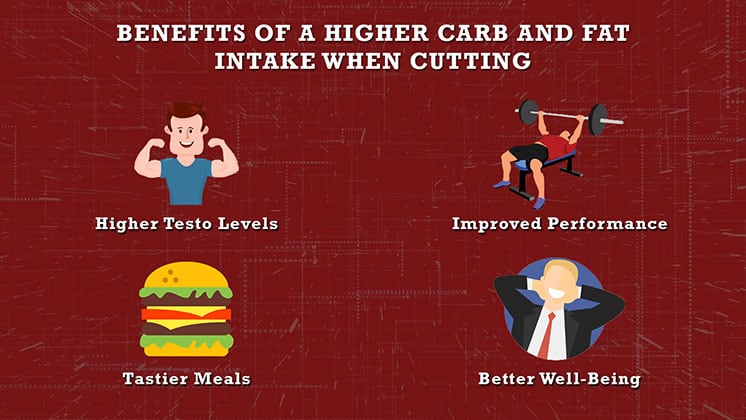
I discussed these benefits in depth in this article. But, here’s a quick break down of them:
1. Higher Testosterone Levels
A calorie deficit combined with a low body fat percentage (~10-12 % and below for males) will always reduce testosterone levels to some extent. That’s been well established by research.
But, the macro intake also plays a vital role for testosterone production. Each of the macronutrients supports the endocrine system and an overall healthy functioning of the body. And the current research shows that
- A low carb diet is bad for testosterone levels
- A low fat diet is also bad for testosterone levels
- High protein diets are in-directly bad for testosterone levels since it forces a lower intake of fats and carbs during a cutting phase.
2. Improved Training Performance
By having a lower protein intake your carbs can be higher. And a higher carb intake has been shown repeatedly by research to improve strength training performance in the gym. What’s worth mentioning is that your performance in the gym is more important than your protein intake when it comes to fat loss.
3. Tastier Meals
Don’t you agree that protein without fats and carbs are boring as hell?
Just think about it; how enjoyable would it be eating only chicken breast without any sauce, cheese, oil, or a side of carbs such as rice, pasta and potatoes for example?
I think most people agree that it’s not an enjoyable diet!
The meals we define as delicious actually contains a balanced intake of all the macros, such as: burgers, pizza, and various pasta dishes etc.
The more protein you include in your diet, the harder it’ll be to have these kinds of meals. Simply because you max out on your carbs and fats before you hit your protein intake.
Want some inspiration for tasty and enjoyable fat loss meals? Check out this article.
4. Overall Better Well-Being
One of the biggest benefit of having more carbs and fat are that both of them improves well-being. And if you feel good on a cut, it’s much more likely that you will stick to it long-term and actually see the results you’re after. Not only that you’ll also be able to easier maintain a lifestyle that you enjoy, while getting lean and muscular in the process.
Again, if you want to read more about the benefits of having a slightly lowered protein intake when cutting, make sure to read this article:
Or watch this video:
Fat
Fat is essential to your survival and it has two main tasks in the body:
- Maintain a healthy hormonal profile (testosterone included).
- To take up your fat soluble, life dependent vitamins a,d,e and k.
Fat is also tasty and makes the food more enjoyable. Including a moderate amount of fat in your diet will, just as I discussed above, improve your adherence and enjoyment to it. Which is the most important aspect when cutting.
So, the fat intake that I recommend are:
- 30-35 % of total calories per day,
This is a bit higher than the usually recommended intake of 20-30 %. Because as I just explained, a bit lower protein intake allows for more carbs and fats, which will improve testosterone levels, training performance, allow for tastier meals and allow you to feel better overall while cutting.
The reason why there’s a range is that some people feel and do better having more fat in their diet, while others feel and do better with more carbs instead.
Why we keep the bottom range at 30 % is because going much lower than this will likely not be sustainable for most people long-term. Simply because food will be less tasty, and that most people tend to not feel satiated and satisfied on a lower fat diet.
Another reason is that sedentary and/or small individuals tend to require a very small calorie intake during a cut. Going below 30 % of calories from fat could lead to hormonal imbalances and other health issues for these people, simply because the fat intake would become too low.
On the other hand, the reason we keep the top range at 35 % is to give more room for our important carbs.
Carbs
Carbs improve strength training performance and recovery, which will lead to more muscle growth/retention during a cut. Carbs has also been shown to improve testosterone levels in men.
Furthermore, carbs has the potential to activate (via tryptophan) a “feel good” neurotransmitter known as serotonin, which has the power to promote feelings of satiety, mood and a sense of overall calmness. All great feelings to experience when cutting.
Since you set your protein and fats first your carbs intake will automatically be:
- The remaining calories
Not sure how many calories you should eat and set your macros after? Read this articles next:
How to Track Your Macros
Okay, so you got your numbers, let’s start tracking.
There are different ways to track your macros. But the easiest and most convenient way would be to use a food tracking app.
Personally, I love MyFitnessPal, so here’s how you use it:
Step 1: Download MyFitnessPal and Set Up an Account
Once you’re in the app, skip the part where the app tries to guide you towards setting up your calories and macros. You’re going to use your own calculated numbers from this post.
Step 2: In MyFitnessPal Set Up Your Correct Calories and Macros
Press the menu tab in the top left, and press Goals.
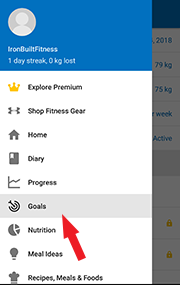
Inside the goals page press Calorie and Macronutrient Goals
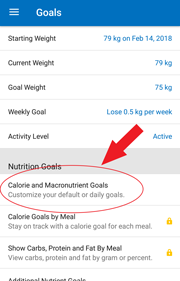
Inside the Calorie and Macronutrient Goals page you are now going to change your calories and macros to the numbers you just calculated.
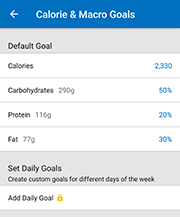
Step 3: Start Adding Your Food in Your Diary
Here’s the power of MyFitnessPal; It contains a database of foods that people around the world adds to the app, and this is amazing news for you!
This gives you the opportunity to eat whichever foods you like from anywhere in the world. All you have to do is just search it up in the search based database and add it to your diary.
And here’s how you do that: Press “+ Add Food” under any meal.
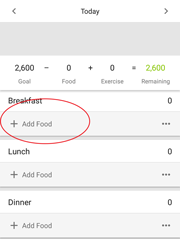
To add your food you can either search the database for your specific food, or you can use the built in camera barcode scanner.
This option simply allows you to scan your packages barcodes and the app will automatically search and show you the exact calories and macros of the food you scanned, like this:
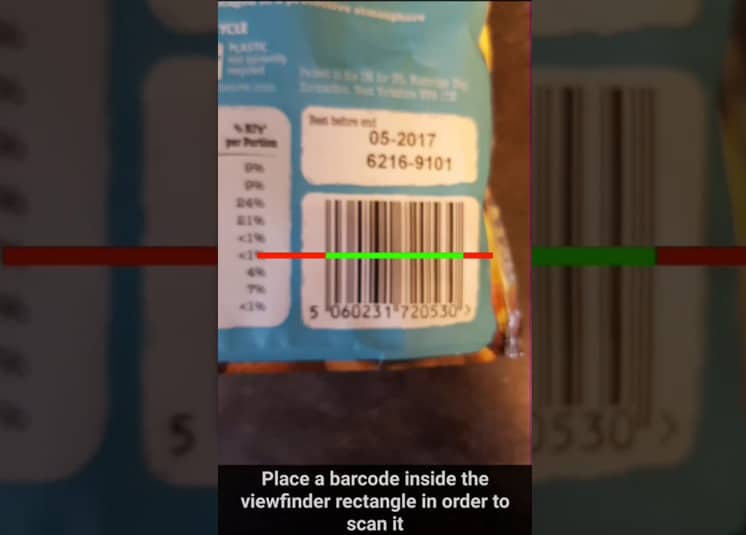
Super simple!
Should You Weigh Your Food Raw or Cooked?
The standard is to weigh all your food raw and uncooked. Since that’s what the nutrition labels are based after.
So, even if meats lose water weight as you cook them, you should still weigh them pre-cooked.
Step 4: Start Hitting Your Macros
The final step is to actually hit your macros. And when you learn to do this correctly, that’s when your flexibility will go through the roof!
Hitting your macros is the first step towards making fat loss feel extremely easy, predictable and enjoyable. But it needs a little initial practice and planning ahead before you’ll get there.
There’s no better time than today to start experimenting adding food to your app. Eventually you will start hitting your macros within good ranges!
And on that note, what’s important to mention is that:
There’s no need to hit your macros perfectly, staying within +/- 5-10 grams of protein, and within +/- 10-15 grams of carbs and fats are perfectly fine.
It won’t matter at all if you get 200 grams of carbs on one day and 185 grams the next day. You won’t feel or notice any difference.
The most important macro to hit consistently is your protein though. As going much lower than 1.8 grams per kg (0.8 grams per lb) of body weight in protein per day will likely result in muscle loss during a cut.
Conclusion
Setting up your macros for cutting correctly is important for muscle retention and adherence to your fat loss diet.
For optimal satiety and enjoyment when cutting I recommend a balanced intake of macros, which is composed of the following numbers:
- Protein: 1.8 grams per kg or 0.8 grams per lb of bodyweight per day.
- Fat: 30-35% of total calories per day.
- Carbs: The remainder of calories left after protein and fat has been set.
When you have these numbers in place then it’s just a matter of finding a tool to track your macros with consistently. I like MyFitnessPal as I believe it’s the most convenient and easy one to use.
Once you got a tool like MyFitnessPal, start adding all the food you eat throughout your days in the built in journal. You do this by weighing your food in its raw state and noting down the numbers.
Finally, hit your macros within good ranges. +/- 5-10 grams of protein and +/- 10-15 grams of carbs and fats are totally fine.

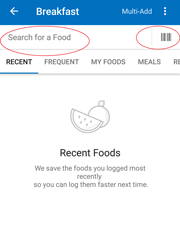
Hi mate just read yr article. Ive read so many different ideas and its all very confusing.
Im male, 49 old, 105kg, and 1.86cm
I want to lean up. Im not sure how to get my caloric intake correct .
Im guessing my protein intake should be around 210g per day?
Once i have the right calories required to lean up i should be able to sort the fats and carb requirements out. Is it based on BMR?
Any advice much appreciated cheers Gav
Hey Gav,
I definitely agree with you, there’s a lot of confusion out there for sure. I remembvr feeling EXACTLY the same when I started.
To answer your question I would recommend that you just track your calories and protein. Make sure you eat in a calorie deficit and that you also eat around 200-210 g of protein per day. Then just let carbs and fats end up where they do. They are a minority and nothing very important to focus on. My only recommendation would be to at least have a fairly balanced intake between carbs and fats as that usually helps with satiety, well-being and health.